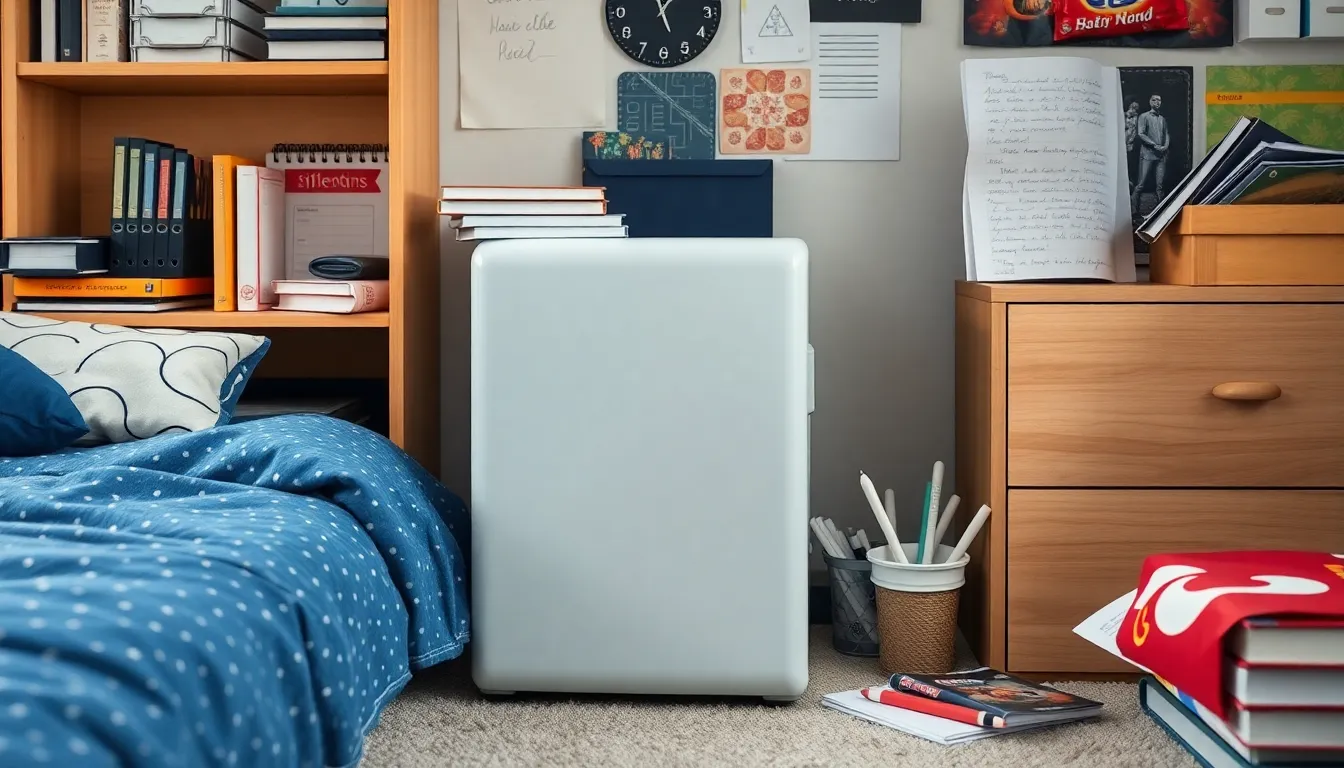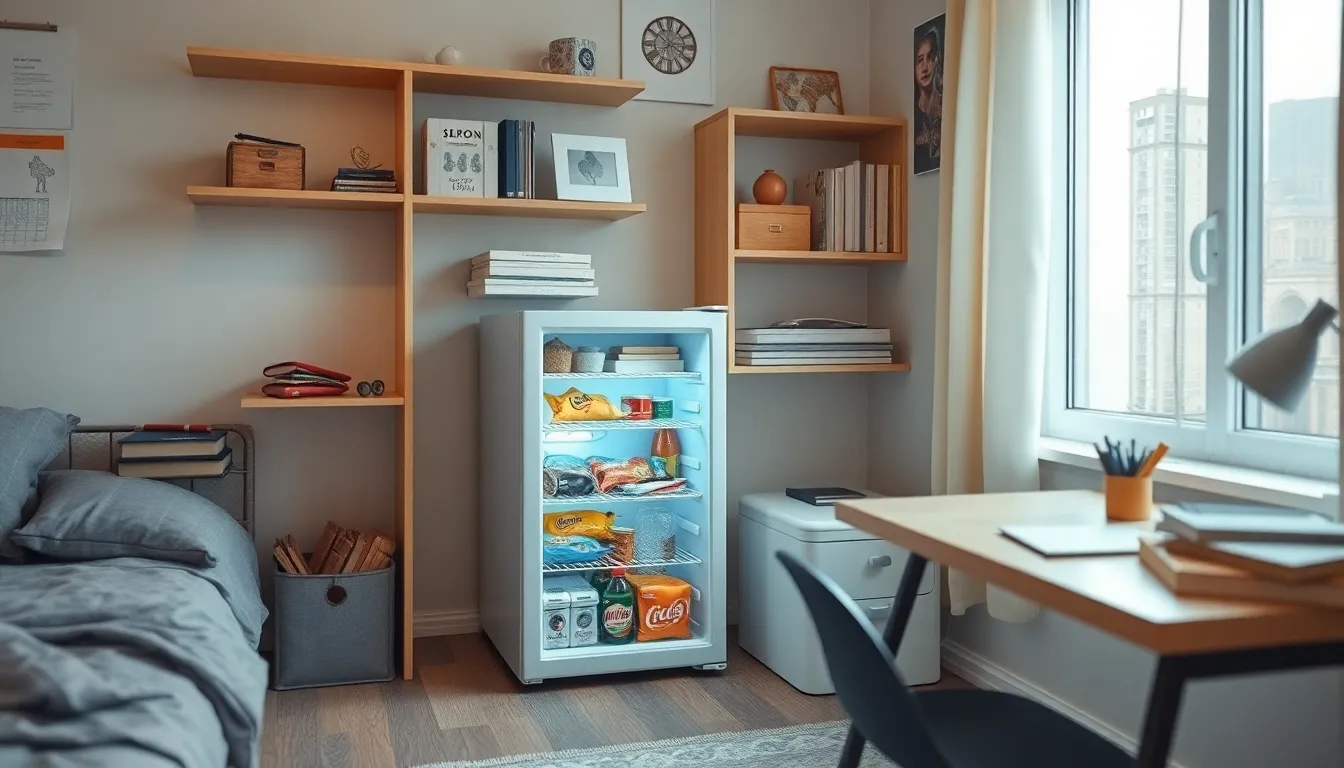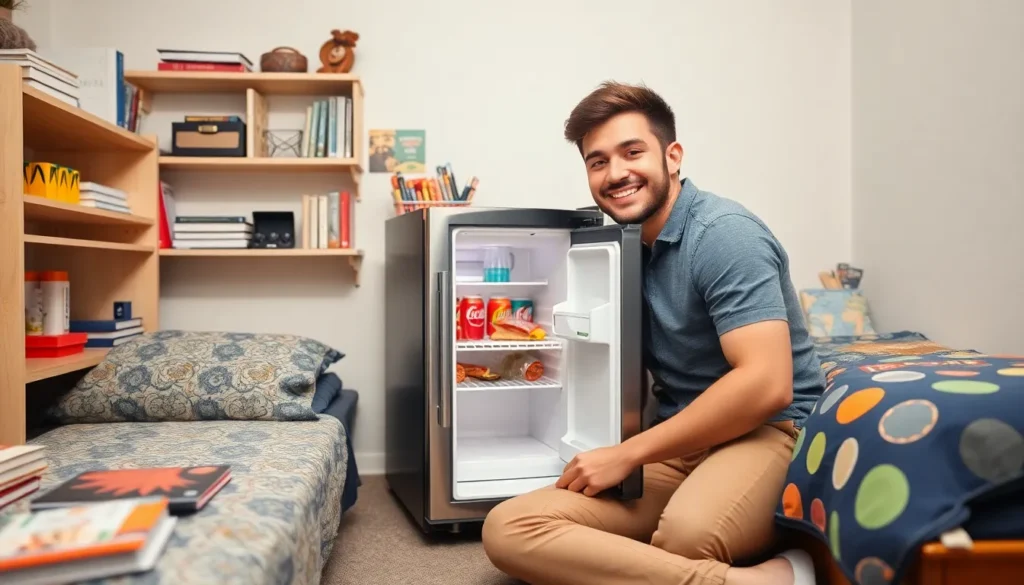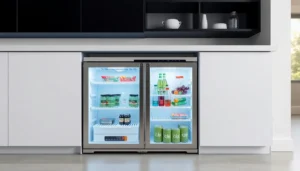Table of Contents
ToggleWhen it comes to dorm life, a mini fridge isn’t just a luxury; it’s a survival tool. Imagine rolling out of bed at 2 AM, craving a midnight snack, only to find your stash of leftovers chilled to perfection just a few feet away. No more late-night treks to the communal kitchen or battling your roommate for the last slice of pizza.
These compact wonders are the unsung heroes of college living. They fit snugly under desks or in tight corners, making them the ideal companion for cramped spaces. Plus, with a mini fridge, students can stock up on snacks, drinks, and even some healthy options, all while keeping their sanity intact. Whether it’s a study session fuelled by energy drinks or a Netflix binge with popcorn, a mini fridge is a game changer for any dorm room.
Overview of Mini Fridges for Dorms
Mini fridges provide essential benefits for college students living in dorms. These compact appliances facilitate access to food and beverages, eliminating the need to visit communal kitchens. Convenience plays a significant role in college life, especially during late-night study sessions or quick meals between classes.
Various sizes and styles of mini fridges are available to fit different dorm layouts. Most models range from 1.7 to 4.5 cubic feet, ensuring a suitable option for nearly every space. Students often choose models with freezer compartments to store ice or easily freeze meals.
Energy efficiency is another critical factor. Many mini fridges consume less electricity than traditional full-size models, which aligns with budget-conscious students looking to save on utility bills. Top-rated units often feature Energy Star ratings, signifying superior efficiency.
Noise levels can also impact a student’s living environment. Quiet operation is a priority for those who need to study or sleep without distractions. College students frequently select models designed specifically for quiet operation, ensuring minimal disturbance.
Storage options within mini fridges vary significantly. Adjustable shelves and door bins provide flexibility for organizing snacks, drinks, and meals. Choosing a model with ample storage capacity can enhance overall convenience, enabling easy access to food items.
Overall, mini fridges represent a valuable investment for dorm dwellers. They enhance the convenience of everyday life by providing quick access to refreshments and snacks. As an essential component of dorm living, these appliances support a balanced lifestyle amid academic demands.
Benefits of Using Mini Fridges


Mini fridges provide multiple advantages for dorm life, enhancing both comfort and practicality for students.
Space-Saving Solutions
Mini fridges fit seamlessly into any dorm room. Their compact designs range from 1.7 to 4.5 cubic feet, allowing easy placement in limited spaces. Students can maximize room layouts by positioning mini fridges under desks or in closets. With adjustable shelves and door bins, storage becomes customizable, catering to individual needs. The smaller footprint enables more space for other essential items, such as study materials or personal belongings. Therefore, students can maintain an organized living area while enjoying the benefits of a refrigerator.
Convenience and Accessibility
Accessing snacks and drinks becomes straightforward with a mini fridge nearby. Late-night study sessions or early morning classes no longer require trips to communal kitchens. Immediate access to refreshments supports healthier snacking habits and reduces the likelihood of unhealthy food choices. With the ability to store fruits, vegetables, and beverages, students can maintain a balanced diet even in a busy academic schedule. The compact size ensures students can enjoy chilled items without interruption while studying or relaxing. Overall, mini fridges simplify day-to-day life, making them invaluable for college students.
Features to Look For
Selecting the right mini fridge for a dorm involves considering several key features. Prioritizing these elements can enhance convenience and usability in limited living spaces.
Size and Capacity
Mini fridges typically range from 1.7 to 4.5 cubic feet in capacity. Students should assess their storage needs based on food preferences and available space in the dorm. Smaller models suit those with limited requirements, while larger options accommodate more snacks and beverages. Dimensions also play a role; a model’s height and width must fit comfortably in designated areas, like under desks or beside beds.
Energy Efficiency
Energy-efficient mini fridges help students save on electricity bills. Many models use less energy than traditional fridges, which is especially important in shared living arrangements. Look for Energy Star ratings indicating high efficiency. These appliances often come with features like temperature controls that optimize energy consumption. Choosing an energy-efficient model can lead to substantial savings over time while being environmentally responsible.
Design and Style
Mini fridges come in various designs and styles to match dorm decor. Some models feature sleek stainless steel finishes, while others offer vibrant colors for a fun touch. Compact designs also enhance portability and fit in tight spaces. Additional features, like reversible doors, add versatility. Students can select styles that reflect their personalities while maintaining functionality and practicality.
Top Mini Fridges for Dorms
Mini fridges offer essential convenience in dorm life, providing easy access to snacks and beverages. Here are some top choices for students looking to enhance their living space.
Popular Brands and Models
Several brands stand out in the mini fridge market. Midea offers the 3.1 cubic feet model, which includes a reversible door and adjustable shelves. Danby features the 2.6 cubic feet design that fits easily under desks while providing sufficient storage. BLACK+DECKER offers models with a sleek design and energy-efficient operation, perfect for dorm environments. Haier provides compact options featuring freezer compartments for added versatility. Options from these brands cater to varying preferences while maintaining quality and functionality.
Price Range Considerations
Mini fridges are available across various price ranges. Students can find budget-friendly options from $100 to $150 for smaller models, while mid-range choices typically fall between $150 and $250 for larger capacities. Premium models might cost $250 and up, often including advanced features like dual temperature zones or smart technology. It’s crucial for students to consider affordability and functionality when selecting a mini fridge. Identifying essential features helps in making a cost-effective choice while ensuring they meet their needs.
Maintenance Tips for Mini Fridges
Cleaning mini fridges regularly prevents odor build-up and keeps food fresh. Wipe down interior surfaces with a mixture of warm water and mild detergent. Rinse with clean water and dry thoroughly to avoid moisture accumulation.
Checking the temperature settings ensures food stays at safe levels. The recommended range is between 32°F and 40°F. Regularly monitoring this helps maintain optimal freshness.
Defrosting requirements vary between manual and automatic models. Manual models require periodic defrosting to prevent ice buildup, while automatic models handle this themselves. Ensure to follow manufacturer guidelines for each type.
Keeping vents clear facilitates proper airflow. Blocking vents hinders cooling efficiency and can lead to higher energy consumption. Regularly inspecting vents helps maintain smooth operation.
Inspecting the door seal is vital for energy efficiency. A tight seal prevents cold air from escaping, promoting better cooling performance. Cleaning the seal with a damp cloth keeps it functioning effectively.
Positioning the fridge properly can enhance performance. Placing it away from heat sources, like radiators or direct sunlight, prevents the appliance from working harder than necessary. This contributes to energy savings.
Organizing contents inside also aids in airflow. Avoid overcrowding shelves, allowing cold air to circulate around food items. Proper organization helps maintain a consistent temperature throughout.
Investing in a surge protector offers additional safety for the electrical components. Sudden power surges can damage the fridge, impacting longevity. Using a surge protector minimizes potential risks.
Following these maintenance tips ensures mini fridges operate efficiently, providing seamless access to snacks and drinks during academic life. Regular upkeep contributes to a better overall experience in dorm living.







